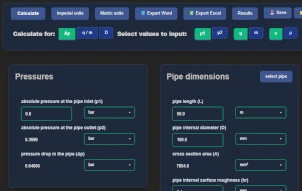Pipe diameter calculator
round, closed, full pipe diameter calculation
Desktop App

Desktop full-featured version.
Free Trial AvailableRegistration
Select a fair price and enable the full service:
- Switch between metric and imperial units in one click
- Export calculation results in Word .docx or Excel .xlsx format
- Preview results on one place and copy/paste it in your favorite text editor
- Send results back to your email
- Support the future of this project
And even more... get access to the full set of 19 desktop calculators available for MacOS, Linux or Windows.
Full Year Service
Prepaid Monthly Cost
$2.50/month
Full year $29.95/year
When is this flow rate calculator applicable?
Calculation of pipe diameter with the pipe diameter calculator is easy. You can use pipe diameter and flow rate calculator for quick pipe diameter calculation in a closed, round, rectangle (online calculator version only) and filled pipes with liquid or perfect gas.
For a calculation of the pipe diameter with this calculator, you should know and enter the flow velocity. It the flow velocity is unknown then you have to use the pressure drop calculator to calculate pipe diameter. You can use pressure drop calculator when the pressure difference between the start and the end of the pipeline (head loss) is available as a known value.
With pipe diameter calculator pipe internal diameter is calculated using the simple relation between flow rate, velocity and cross-section area (Q=v·A).
To calculate internal pipe diameter, you should only enter flow rate and velocity in corresponding fields in the calculator and click calculate button to get results.
Other values, besides internal pipe diameter, can be calculated as well. You can calculate flow velocity for the given fluid flow rate and internal pipe diameter. As velocity is different on different places of pipe cross-section area, flow mean velocity is computed based on the continuity equation.
The flow rate used in calculator can be mass or volume flow rate.
Conversion between mass and volume flow rate is available for given fluid density. Also, for perfect gases, volume flow rate conversion for different flow conditions (pressures and temperatures) is possible, so you can quickly calculate the volume flow rate on specific pressure or specific temperature in the pipe, like after pressure reducing valves.
If flowing fluid is perfect gas, you can calculate volume flow rate of that gas at different pressures and temperatures. For example, if you know volume flow rate of some ideal gas at some predefined pressure and temperature (like at normal conditions p=101325 Pa and T=273.15 K), you can calculate actual volume flow rate for pressure and temperature that is actually in the pipe (for example, the real pressure and temperature in the pipeline is p=30 psi and t=70 F). Volume flow rate of the perfect gas is different at these two conditions. Read more about normal conditions for pressure and temperature.
With this calculator, you can convert volume flow rate from standard or some other predefined conditions to actual conditions and vice versa. The calculator uses the mass conservation law for computation of volume flow rates for this two conditions, meaning that mass flow is constant, despite that conditions, like pressure and temperature are changing.
The mass conservation law is applicable only if the stream is in the closed pipe, without added or subtracted flow, if the flow is not changing in time and a few other conditions. Read more about mass conservation of mass.
So when flow rate calculator is not applicable?
This pipe diamteter and flow rate calculator has an almost limitless application, but some functionalities are dependent on several conditions.
As mentioned above, pipe diameter calculation with this calculator is not possible if you are not sure about flow velocity and volume/mass flow rate. If any of these two are missing, then you should use pressure drop calculator.
You have to know the density of the liquid if the mass flow rate is available instead of the volume flow rate. If the density of the liquid is unavailable, and only the mass flow rate is known, then the volume flow rate required for pipe diameter calculation is not possible.
For perfect gases, the density of the fluid is not mandatory, if you know the pressure, temperature and gas constant for the flowing gas. The calculator uses the perfect gas equation for density calculation. However, if the flowing fluid is gas but not a perfect (ideal) gas, i.e., if it's pressure, temperature and density are not related according to ideal gas law, this calculator is not applicable if you are trying to calculate that gas density for known pressure and temperature.
What has to be known to calculate pipe diameter?
To calculate pipe diameter, you have to know flow velocity and flow rate. If you know mass flow rate, then fluid density has to be known.
If the flowing fluid is gas, then instead of density, you have to know gas constant, absolute pressure, and temperature. Density is calculated using the equation for the perfect gas.
What has to be known to calculate flow velocity?
To calculate flow velocity, you have to know flow rate and pipe interior diameter. If you know mass flow rate, then fluid density has to be known.
If the flowing fluid is gas, then instead of density, you have to know gas constant, absolute pressure, and temperature. Density is calculated using the equation for the perfect gas.
How is the calculation performed?
Pipe diameter and flow velocity calculation use the continuity equation that gives the relation between flow rate, flow velocity, and interior pipe diameter.
For gas flow, the equation for perfect gas is used to calculate density from gas constant, absolute pressure, and temperature.
Register account and unlock full access
Desktop App

Fast. Accurate. Reliable.
Features in desktop app
- Save/Open multiple results
- Export to Word and Excel
- Print results
- Create list of custom fluid properties
- Resistance factor K for valves/fittings
- Pipe surface roughness selection
- Pipe material selection
- Gauge vs absolute pressure toggle
- Compressible isothermal flow
- Dry air isothermal flow
- Gas offtake flow
- Natural gas flow
- No admin rights required to install
Need a helping hand?
Powered by natural intelligence - NI

If you need a quick calculation, but you are not still familiar how to use the calculator, you can order calculation service from the calculator developer.


